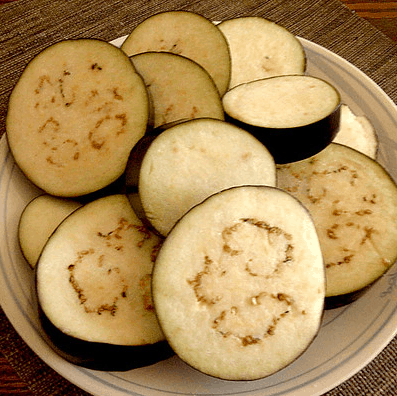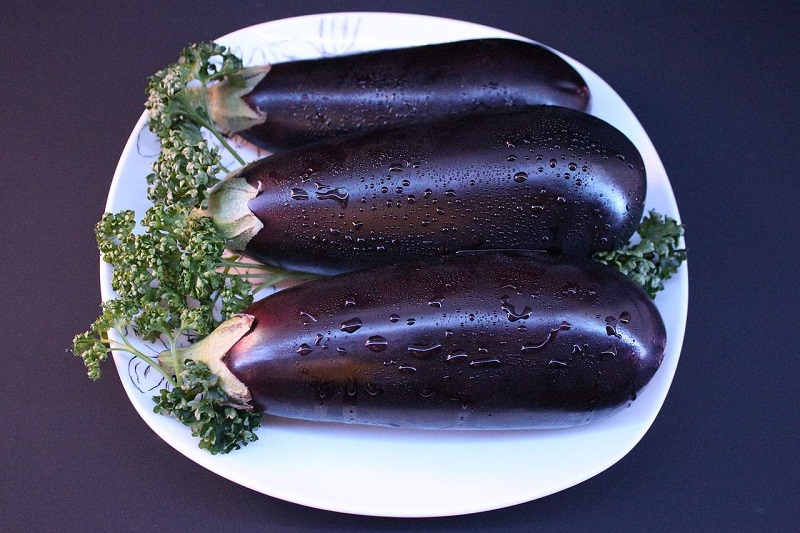Many of our follower have ask What Should The Inside of an Eggplant Look Like in this article we tell you all about it.
Eggplant is a vegetable of the nightshade family, which comes from India, where they have been cultivated for more than 4000 years.
It is a vegetable that for many years had a bad reputation, as it was thought to be toxic and could even cause insanity (hence its first scientific name Solanum insanum).
In addition to being one of the most consumed and versatile foods in our Mediterranean diet, aubergine is more than healthy. We invite you to know all its benefits and properties.
It is important to know that this food must be consumed always cooked and never raw. This is due to solanine, a substance that it contains and that can be very toxic.
You may like What Color Light Is Best For Plant Growth
Its properties make eggplant an ideal food to fight cancer, cellular aging, infections, viruses and harmful bacteria:
Its water content is very high (92%).
Fiber.
Minerals: potassium, calcium, sulfur, and iron.
Vitamins of group B and C.
Contains serotonin.
It provides a large number of antioxidant substances, such as chlorogenic acid or flavonoids.
It is low in calories (21.2 kcal per 100 grams).
Small amounts of the alkaloid called solanine.
Like eggplant? We LOVE this delicious eggplant caponata imported from italy. It’s so good and very affordable!
What Should The Inside of an Eggplant Look Like

Eggplant flesh will have light tan to brown colored spots around the seeds.
If this is the color you are referring to, it is edible. Sometime if the eggplant grows too old the inside could be brown in does cases the inside could be spoil or in the prosses.
If you eat it you wont get sick but it does not have the same flavor.
If you only see some brown spots but most are white or tan it is edible.
How to grow eggplant
How to Grow Eggplants Step by Step:
When? Between March and May.
Where? Place of maximum solar exposure. Between 6-8 hours a day of minimum sun.
Harvest time? Between 60 and 90 days from sowing, sow eggplants 1
How do we prepare the earth? Stirred, airy, drain well. A pH of 6-7.
How do we pay? Abundant organic matter and earthworm humus.
Manure and organic waste (compost) are recommended.
How do we water? Ideal with drip. Requires a lot of water.
How often do we water? In summer daily, between 30-40 minutes.
How do we sow? They require a lot of space. Bury two seeds together. Leave a gap of 50-70cm between the other seeds you sow.
How do we harvest? Requires pruning of suckers and other stems.
Dry cut on the stem of the fruit. Ideal with scissors.
Good associations? Garlic, celery, onion, cabbage, spinach, lettuce, radishes, nasturtium, and carrots.
Bad associations? Cucumber and zucchini
Plagues and diseases? Potato beetle, red spider, whitefly, thrips, mildew and powdery mildew.
Sowing
Although eggplant can be sown directly in the garden, it is always best for the beginning gardener to use transplants.
If you can’t find the varieties you want at garden centers, be sure to germinate the seeds 6 to 8 weeks before they are going to be transplanted outside. Grow the seeds indoors.
They will germinate in 5 days if you keep them at 86 degrees F, but it could take up to 14 days at 65 degrees F.
Eggplant is a tropical plant, so it is very sensitive to cold and should not be planted outside until all has passed. frost risk and until daytime temperatures are at least 65 degrees F. Plants will grow 2 to 4 feet, so give them 24 to 36 inches apart.
Fertilization
Eggplant needs a constant supply of nutrients. It is best to do an analysis of your soil and follow the recommendations.
If you don’t test your soil, add a total of 2 to 3 pounds of a complete fertilizer (6-12-12, 10-10-10, or 09-16-16) per 1,000 square feet. Apply half of the fertilizer before planting and the other half after the first fruits appear.
After transplanting the eggplants, pour ¼ cup of liquid fertilizer around each plant. Prepare a solution by dissolving 2 tablespoons of complete fertilizer in 1 gallon of water.
Irrigation
Eggplants also need water consistently, at least 1 inch per week. It is better to water them deeply less often since frequent superficial irrigations promote shallow roots.
Weather and soil type affect water demand. High temperatures, strong winds, and sandy soils will increase the need for water.
Watch out
Keep weeds under control because they compete with plants for water, nutrients, and light. There are many types of mulch or mulch, both organic and inorganic, that can be used to conserve soil moisture and reduce weed competition.
Diseases
A number of diseases can harm eggplants at various stages, including seed rot, seedlings, anthracnose, late blight, leaf spotting, and verticillium wilt.
Three conditions must be met for a disease to proliferate: the presence of the disease pathogen, a susceptible host, and a favorable environment. If any of these elements is missing, the disease cannot be transmitted. It is much easier to prevent a disease than to control it.
Diseases can be prevented by planting resistant varieties, rotating crops, watering properly and giving enough plant separation, and practicing good hygiene (such as discarding diseased plants).
Harvest
Its fruit can be harvested when they are between a third and full size. Harvest them before the skin becomes dull and the seeds harden. A general rule of thumb is that if you lightly press one side of the fruit with your thumbnail and the mark remains, the fruit is ripe and ready to be picked.
Fruit can be plucked from the plant, but is better for the plant if cut. Be careful with the thorns on the stem of the fruit, as they can hurt the hand if you do not wear gloves. Handle the harvested fruit carefully so that it is not overrun.
Storage
The collected fruit can be stored for a week at 45 to 50 degrees F with 90 percent humidity.
Conclusion
There is no comparison between the taste of a garden-fresh tomato and a grocery store-bought one that’s devoid of flavor.
The nature of the American food system is that grocery store produce has often been grown hundreds of miles away, meaning it can be days between harvest and your table. This process results in the quality of the produce often being compromised.
Thats why I recommend to always grow vegetables in your garden if possible. You will get better food to your table
Though growing your own vegetables can seem overwhelming to some, it’s actually much simpler than it sounds. Even if you don’t have a yard, consider starting a patio garden or even an indoor herb garden on a windowsill. You’ll be amazed at how many tomatoes or peppers you can grow out of one pot!

1 thought on “What Should The Inside of an Eggplant Look Like”
Comments are closed.